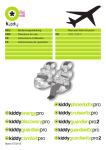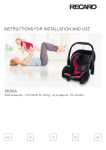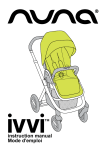Download kiddy Guardian Pro 2
Transcript
DEU ENG Bedienungsanleitung Directions for use Stand 04/2011 I KR Manuale delle istruzioni 제품 설명서 1. Einleitung DEU Um einen sicheren Transport von Kindern im Flugzeug zu gewährleisten darf dieser Kindersitz auch im Flugzeug verwendet werden. Da dieser Kindersitz in erster Linie zur Verwendung im Auto konstruiert wurde, weicht die Befestigung im Flugzeug von der im Auto ab. 2. Allgemeine Sicherheitshinweise Lesen Sie vor einem Flug bitte unbedingt die Bedienungsanleitung für den Einbau des Kindersitzes im Flugzeug und machen Sie sich mit den Besonderheiten vertraut! Eine falsche Benutzung kann für Ihr Kind lebensgefährlich sein. Wenn Sie den Kindersitz im Flugzeug verwenden wollen, informieren Sie sich bitte vorher bei Ihrer Airline über die speziellen Beförderungsbedingungen! Die Verwendung des Kindersitzes mit einem 2-Punktgurt ist nur im Flugzeug erlaubt. Der Kindersitz darf nur auf einem, von der Airline freigegebenen Platz installiert werden. Der Kindersitz darf nicht im Wirkbereich eines Airbags installiert werden. Stellen Sie den Kindersitz auf die Körpergröße Ihres Kindes ein und richten Sie sich hierbei nach den Empfehlungen der KfzBedienungsanleitung des Kindersitzes. Nehmen Sie immer den im Zubehör erhältlichen Gurtverkürzer mit ins Flugzeug! Dieser Gurtverkürzer wird (i.d.R.) zur Verwendung des Kindersitzes im Flugzeug benötigt (siehe 3.1.1). Dieser muss von Ihnen mitgebracht werden und wird nicht von der Airline gestellt. Ohne den Gurtverkürzer ist es möglich, dass Ihr Kindersitz nicht richtig angeschnallt werden kann. Sie können den Gurtverkürzer bei kiddy bestellen. 1 DEU 3. Einbau im Flugzeug Falls Ihr Kindersitz über k-fix Konnektoren verfügt, müssen diese in das Sitzinnere eingezogen werden. Mit ausgefahrenen k-fix Konnektoren ist ein Einbau im Flugzeug nicht möglich. Schlagen Sie hierfür in der Bedienungsanleitung Ihres Kindersitzes nach. Der Kindersitz muss immer mit einem Sitzgurt gesichert sein, auch dann, wenn das Signal zum Anlegen der Sicherheitsgurte während des Fluges ausgeschaltet worden ist. Ein ungesicherter Kindersitz könnte bei einem Unfall, Turbulenzen oder einer Notlandung andere Passagiere verletzen. 3.1 Einbau mit Fangkörper (9 - 18 kg) Stellen Sie den Kindersitz auf den entsprechenden Sitzplatz und klappen Sie die Armlehnen des Flugzeugsitzes nach oben. Setzen Sie Ihr Kind in den Kindersitz und schieben Sie den Fangkörper in die Führungsschlitze am Sitzteil. Führen Sie den Gurt in die Fangkörpergurtführungen ein (A) und schließen Sie das Gurtschloss (B). Achten Sie darauf, dass die Gurte nicht verdreht verlaufen. Straffen Sie den Gurt, indem Sie an dem losen Ende ziehen. 2 DEU Es kann vorkommen, dass der Kindersitz nicht wie beschrieben angeschnallt werden kann. Wenn das Gurtschloss im Bereich der Fangkörpergurtführungen liegt, könnte dies das Einrasten ins Schloss oder das Straffen des Gurtes verhindern. Sollte die beschriebene Situation eintreten, muss der Gurtverkürzer benutzt werden (siehe Punkt 3.1.1). Diesen können Sie bei kiddy bestellen. An manchen Flugzeugsitzen ist die Armlehne nicht klappbar und in Ausnahmefällen kann es vorkommen, dass das Gurtschloß zwischen Armlehne und Kindersitz eingeklemmt wird und sich nicht öffnen lässt. Sollte die beschriebene Situation eintreten, muss ein Verlängerungsgurt benutzt werden (siehe Punkt 3.1.2). Diese Gurte sind immer an Board! 3.1.1 Einbau mit Fangkörper und Gurtverkürzer Fädeln Sie den Gurtverkürzer auf den Gurt bis alle 4 Haken hinter dem Gurt liegen (gelbe Pfeile). Rollen Sie den Gurtverkürzer einmal auf und fädeln Sie dann das lose Ende des Gurtes hinter die freien Haken ein. 3 DEU Sollte das Gurtschloss immer noch im Bereich der Gurtführungen liegen, muss der Gurt eine weitere Drehung aufgerollt werden. Rollen Sie den Gurtverkürzer ein weiteres Mal auf und fädeln Sie dann das feste Ende des Gurtes vor die freien Haken ein. 3.1.2 Einbau mit Fangkörper und Verlängerungsgurt Verbinden Sie den Verlängerungsgurt mit dem fest am Sitz angbrachten Gurt. Führen Sie die Gurte in die Gurtführungen ein und schließen Sie das Gurtschloß. 4 DEU Straffen Sie die beiden losen Enden der Gurte. Positionieren Sie das Gurtschloss in der Mitte des Fangkörpers, dass es gut erreichbar ist. 3.2 Einbau ohne Fangkörper (15 - 36 kg) Für die Benutzung des Kindersitzes ohne Fangkörper muss Ihr Kind ein Gewicht von mindestens 15kg erreicht haben. Stellen Sie den Kindersitz auf den entsprechenden Sitzplatz und klappen Sie die Armlehnen des Flugzeugsitzes nach oben. Führen Sie die beiden Enden des Beckengurtes in die Gurtführungen am Sitzteil ein. Achten Sie darauf, dass die Gurte nicht verdreht verlaufen! Schließen Sie nun das Gurtschloss (A) und straffen Sie den Gurt (B). 5 DEU Es kann es vorkommen, dass der Kindersitz nicht wie beschrieben angeschnallt werden kann, z. B. wenn das Gurtschloss in den Beckengurtführungen des Kindersitzes liegt und sich nicht (oder nur schwer) öffnen lässt. Sollte die beschriebene Situation eintreten, muss der Gurtverkürzer (siehe Punkt 3.1.1) oder der Verlängerungsgurt (siehe Punkt 3.1.2) benutzt werden. 4. Ausbau des Kindersitzes Lösen Sie den Beckengurt gemäß Anweisung Ihrer Airline. Vergessen Sie nicht, den Gurtverkürzer vom 2-Punkt-Flugzeuggurt zu entfernen! 6 ENG 1. Introduction This child safety seat can also be used in an aircraft to ensure the safe transport of children on an airplane. Since this child car seat was primarily designed for usage in a motorcar, its fastening on the airplane differs from its fastening in the car. 2. General safety instructions Please read the instructions for installing the child car seat on the airplane carefully and familiarise yourself with the specific requirements! Incorrect installation can endanger the life of your child. If you want to use the child car seat on an airplane, please ask your airline about the specific transport conditions in advance. The use of a child car seat is only allowed on a plane with a 2-point belt. The child car seat may only be installed on a seat on the plane determined by the airline. The child car seat may not be installed within the effective range of an airbag. Adjust the child car seat to the size of your child in accordance with the recommendations in the instruction manual of the child car seat. Always take the belt shortener on the plane! - you can order it at kiddy. This belt shortener is (usually) required to use the child seat on the plane (refer to 3.1.1). You have to bring it with you since it is not provided by the airline. It is possible that your child car seat cannot be fastened correctly without the belt shortener. 1 3. Installation on the airplane ENG If your child seat is equipped with k-fix connectors, they have to be retracted into the seat. An aircraft installation is not possible when the k-fix connectors are extended. Check child seat operating manual. The child seat always has to be secured with the safety belt, even when the “Fasten your seat belt.” signal is switched off. A unsecured child seat could injure passengers in case of an accident, turbulences or an emergency landing. 3.1 Installation with impact shield (9 - 18 kg) Place the child car seat on the respective seat on the plane and fold the armrests of the plane seat upwards. Place your child in the child car seat and move the impact shield into the guide slots of the car seat. Feed the belt through the impact shield belt guides (A) and close the belt buckle (B). Make sure that the belts are not twisted. Tighten the belt by pulling the loose end. It is possible that the child car seat cannot be fastened as described. If the belt buckle is located in the area of the impact shield’s belt guides, this could prevent the clip from locking in place or the correct tightening of the belt. 2 ENG If this situation occurs, the belt shortener has to be used (refer to point 3.1.1). If not provided you can order the belt shortener at kiddy. With some airplane seats the armrests are fixed and in exceptional cases it is possible that the belt buckle will be jammed between the armrest and the child car seat and cannot be opened. If the described situation occurs, a belt extender has to be used (refer to point 3.1.2). These belt extenders are always on the airplane. 3.1.1 Installation with impact shield and belt shortener Thread the belt shortener onto the belt until all four hooks lie behind the belt (yellow arrows). Roll the belt shortener up and thread the loose end of the belt behind the free hooks. 3 ENG If the belt buckle still lies in the area of the belt guides, the belt must be rolled up one more rotation. Roll the belt shortener up once more and thread the fixed end of the belt in front of the free hooks. 3.1.2 Installation with impact shield and belt extender Attach the belt extender to the belt fixed to the seat. Feed the belts through the belt guides and close the belt buckle. 4 ENG Tighten both loose belt ends. Position the belt buckle in the centre of the impact shield, so that it is easily accessible. 3.2 Installation without impact shield (15 - 36 kg) If the child car seat is used without impact shield, your child must weigh at least 15 kg. Place the child car seat on the respective seat on the plane and fold the armrests of the plane seat upwards. Feed both ends of the lap belt through the belt guides of the child car seat. Make sure that the belts are not twisted! Now close the belt buckle (A) and tighten the belt (B). 5 ENG It is possible that the child car seat cannot be fastened as described, e.g. when the belt buckle lies in the lap belt guides of the child car seat and cannot, or cannot easily, be opened. If the described situation occurs, the belt shortener (refer to point 3.1.1) or the belt extender (refer to point 3.1.2) have to be used. 4. Removing of the child car seat Unfasten the lap belt according to the instructions of your airline. Do not forget to remove the belt shortener from the 2-point airplane belt. 6 I 1. Introduzione Questo seggiolino può essere utilizzato anche in aereo per garantire la sicurezza del trasporto dei bambini su un aereo. Dal momento che questo seggiolino è stato progettato principalmente per l'uso in automobile, il suo fissaggio a bordo del velivolo differisce dal suo fissaggio in auto. 2. Istruzioni generali di sicurezza Si prega di leggere le istruzioni per l'installazione del seggiolino su l'aereo con attenzione e familiarizzare con le esigenze specifiche! Un'errata installazione può mettere a rischio la vita del tuo bambino. Se si desidera utilizzare il seggiolino auto su un aereo, si prega di informarsi presso la vostra compagnia aerea sulle condizioni di trasporto in anticipo. L'uso del seggiolino auto può essere utilizzato solo con una cintura a 2 punti Il seggiolino può essere installato su un sedile dell'aereo scelto dalla compagnia Il seggiolino auto non può essere installato nel raggio di azione di un airbag Regolare il seggiolino secondo dimensioni del vostro bambino in conformità con le raccomandazioni del manuale di istruzioni Utilizzare sempre la riduzione cintura sull'aereo! - Si trova tra gli accessori della seduta. Questa riduzione cintura è (solitamente) necessaria per utilizzare il seggiolino sull'aereo (vedi 3.1.1). Dovete portare con voi, in quanto non è fornito dalla compagnia aerea. E 'possibile che il seggiolino auto non può essere fissato correttamente senza questa riduzione cintura. 1 I 3. Istallazione sull'aereo Se il vostro seggiolino è equipaggiato con connettori k-fix, devono essere retratti nel seggiolino. L’installazione in aereo non è possibile con i connettori k-fix allungati. Controllate il vostro manuale istruzioni del seggiolino. Il seggiolino auto va sempre assicurato con le cinture, anche quando il segnale “Allacciare le cinture” è spento. Un seggiolino non assicurato potrebbe ferire i passeggeri in caso di incidente, turbolenze o un atterraggio di emergenza.” 3.1 Istallazione con cuscino addominale (9 - 18 kg) Posizionare il seggiolino per bambini sul sedile dell'aereo e piegare il bracciolo del sedile verso l'alto. Posizionate il vostro seggiolino e inserite il cuscino addominale nelle guide dello stesso seggiolino. Fate passare la cintura nelle guide del cuscino (A) e agganciate la fibbia (B). Assicurarsi che le cinture non siano attorcigliate. Stringere la cintura tirando le parti lente. Può accadere che il seggiolino non sia montato come descritto. Se la fibbia della cintura si trova nella zona delle guide del cuscino, questo potrebbe impedire che la clip si possa chiudere o il corretto blocco della cintura. 2 I Se si verifica questa situazione, la riduzione cintura deve essere utilizzata (vedi punto 3.1.1). Se non presente è possibile ordinare la cintura presso kiddy. Alcune volte i braccioli del sedile dell'aereo siano fissi e in casi eccezionali è possibile che la fibbia della cinta si inceppi tra il bracciolo e il seggiolino e non può essere aperta. Se succede una situazione del genere, bisognerà utilizzare la prolunga per cintura (riferimento al punto 3.1.2). Questa prolunga è sempre presente in aereo. 3.1.1 Istallazione con il cuscino di impatto e riduzione cintura Inserire la riduzione cintura all'interno delle guide fino a quando i 4 ganci sono dietro la cinta (frecce gialle). Arrotolare la riduzione della cintura e bloccarla attraverso i ganci dietro. 3 I Se la fibbia della cintura si trova ancora nella zona delle guide, deve essere arrotolato ancora una volta. Arrotolare la riduzione cintura ancora una volta e bloccare la parte finale con i ganci davanti. 3.1.2 Istallazione con il cuscino addominale e la prolunga cinta Agganciare la prolunga alla cintura del sedile. Inserire la cintura attraverso la guida cinture e agganciare la cintura. 4 I Stringere entrambe le estremità della cintura allentate. Posizionare la fibbia della cintura al centro del cuscino addominale, in modo che sia facilmente accessibile. 3.2 Istallazione senza cuscino addominale (15 - 36 kg) Se il seggiolino viene utilizzato senza cuscino di protezione, il bambino deve pesare almeno 15 kg. Mettere il seggiolino nel rispettivo sedile dell'aereo e alzare i braccioli del sedile verso l'alto. Inserire la cintura attraverso le guide cintura del seggiolino auto. Assicurarsi che attorcigliata. la cinture non sia Ora agganciare la cintura (A) e stringere (B). 5 I Può accadere che il seggiolino non può essere fissato come descritto, ad esempio, quando la fibbia della cintura si trova nelle guide cintura del seggiolino auto e non può (o con difficoltà), essere aperto. Se succede una situazione del genere, bisognerà utilizzare la prolunga per cintura (riferimento al punto 3.1.2). Questa prolunga è sempre presente in aereo. 4. Rimozione del seggiolino auto Sganciare la cintura in base alle istruzioni del vostro compagnia aerea. 6 KR 1. 소개 이 유아용 안전 장치는 비행기 내에서 안전 장치로 사용이 가능 합니다. 이 차량용 안전장치는 차량에서의 사용 목적을 위해 만들어 졌기 때문에 차량에서의 사용 방법과 비행기에서의 사용 방법은 다를 수 있습니다. 2. 일반적인 안전 수칙 카시트를 사용 하기 전 반드시 매뉴얼을 확인하여 안전수칙을 숙지 하여야 합니다. 제품이 잘 못 설치 되었을 경우 아이가 부상을 당할 위험이 있습니다. 만약 카시트를 비행기에서 사용 할 경우 항공사 직원에게 카시트 사용을 미리 알리고 장착이 가능한지 확인 하여야 합니다. 이 차량용 안전 시트를 사용 할 경우 좌석에 2 점식 안전벨트가 장착이 되어 있어야 합니다. 카시트는 항공사에서 지정한 좌석에만 설치가 가능 할 수도 있습니다. 본 카시트는 에어백이 설치된 곳에서의 사용을 금지 합니다. 카시트의 사이즈를 아이의 체형에 맞춘 후 사용 하여야 합니다. 비행기에서 사용시 시트에 장착되어 있는 Belt Shortener 함께 사용 하여야 하며, 이 Belt shortener 는 유아가 비행기 탑승시 같이 착용해야 하는 것으로 만약 비행기에 이 장치가 없을 경우 비행기 탑승시 직접 가져가야 합니다. 만약 Belt Shortener가 없을 경우에는 카시트가 고정이 되지 않아 원활한 사용이 불가능 합니다. 1 KR 3. 비행기에서의 설치 당신의유아용시트가 K-FIX CONNECTOR로연결되어있다면, 시트안으로밀어넣으셔야합니다. K-FIX CONNECTOR가확장되어있으면, 비행기내설치가불가능합니다. 작동매뉴얼을확인하세요. 유아용 시트는 “안전벨트 착용” 신호가 꺼져있을 때에도 항시 안전벨트로고정되어 있어야 합니다. 안전하게 착용되어 있지 않은 유아용 시트는 난기류 혹은 비상착륙과 같은 사고에 다른 승객들이 다칠 위험이 있습니다. 3.1 임팩트 쉴드의 설치 (9 - 18 kg) 카시트를 좌석에 올린 후 팔걸이를 올린다. 아이를 카시트에 태운 후 임팩트 쉴드를 슬롯에 장착 한다. 벨트를 임팩트 쉴드에 고정 시킨 후 벨트의 버클을 잠근다. 벨트가 뒤틀려 있지 않은지 확인 한다. 벨트의 끝을 당겨 고정이 될 수 있도록 한다. 시트의 벨트 버클이 임팩트 쉴드에 걸려 카시트가 시트에 고정이 되지 않을 수도 있습니다. 이럴 경우 Belt Shortener를 사용하여 카시트를 고정 하여야 하며 만약 Belt Shortener가 제공 되지 않을 경우 Kiddy에서 주문 가능 합니다. 2 KR 만약 비행기의 팔걸이가 고정이 되어 있을 경우에는 예외로 카시트를 팔걸이에 끼워 벨트 버클을 사용해 카시트를 완전히 고정 시킨다. 만약 위의 상황이 발생할 경우 확장 벨트가 필요하며, (Point 3.1.2 참고) 확장 벨트는 항공기에 상시 보유하고 있으므로 승무원에게 문의해 장착 함. 3.1.1 임팩트쉴드와 Belt Shortener 장착 Belt Shortener 를 벨트위로 올려 4개의 훅에 모두 걸리게 장착 한다(노란색 화살표 참고). Belt Shortener를 감아 올리고 남은 벨트는 훅 뒤에 고정 한다. 3 KR 만약 벨트 버클이 벨트 가 지나가는 위치에 있다면 벨트를 한번 더 감아 위치를 변경 시킨다. Belt Shortener를 감아 올려 앞에 있는 훅에 한번 더 고정 시킨다. 3.1.2 임팩트쉴드와 확장벨트 장착 확장벨트를 벨트에 고정해 시트에 고정 시킨다. 벨트 가이드를 이용해 벨트를 넣고 벨트 버클을 잠근다. 4 KR 양 끝의 남은 벨트를 조여 주고, 벨트 버클을 임팩트 쉴드의 중앙에 오도록 조절한다. 3.2 임팩트 쉴드를 제거한 착용 방법 (15 - 36 kg) 임팩트 쉴드를 제거한 사용은 아이가 15kg이상이 되었을 때 사용 가능 합니다. 카시트를 자리에 올린 후 팔걸이를 올린다. 벨트를 카시트의 벨트 통과 위치에 올려 고정 시킨다. 벨트가 꼬인 부분이 없는지 확인 한다. 벨트 버클 (A)와 (B)를 잠근 후 고정 시킨다. 5 KR 설명 과 같이 제품이 시트에 고정이 되지 않을 경우가 발생 할 수도 있습니다. 예) 벨트 버클이 카시트의 벨트 가이드 부분에 있을 경우 버클을 열지 못하거나 여는데 어려움을 겪을 수도 있습니다. 만약 위의 상황이 발생 했을 경우, Belt Shortener나 확장 벨트를 사용 하여야 합니다. 4. 카시트를 시트에서 분리 항공사 규정에 맞게 벨트를 풀어 카시트를 분리 합니다. 6 kiddy GmbH Schaumbergstr. 8 D-95032 Hof / Saale Phone: 0049 (0)9281 / 7080-0 Fax: 0049 (0)9281 / 7080 -21 E-mail: [email protected]
This document in other languages
- Deutsch: kiddy Guardian Pro 2
- italiano: kiddy Guardian Pro 2





























